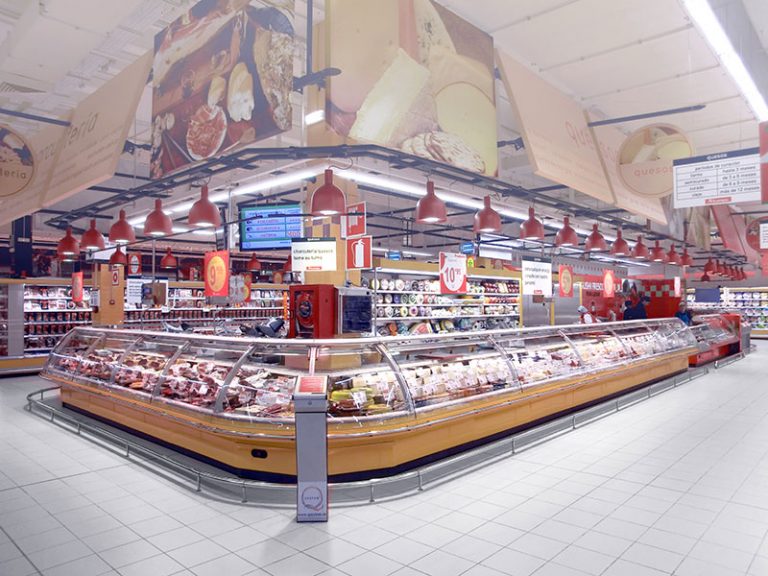Understanding Industrial Refrigeration
Industrial refrigeration plays a vital role in multiple industries such, as food and beverage, pharmaceuticals and chemicals. It utilizes large scale refrigeration systems to ensure that perishable goods are stored, processed and transported at low temperatures.
Best Practices for Energy Efficiency:
Optimize Insulation: It should be made sure that the refrigeration equipment and pipelines are properly insulated to reduce heat transfer and save energy. It’s important to check and maintain the insulation to avoid any potential damage or deterioration.
Implement Variable Speed Drives: One way to save energy is by installing variable speed drives (VSDs) in order to control the speed of compressors, fans and pumps according to the specific cooling needs. VSDs are effective, in reducing energy consumption by adjusting the motor speed based on the load.
Optimize Refrigeration System Design: It should be made sure to design the refrigeration system with the size and capacity to prevent it from cooling too much or too little. It’s important to use energy components and technologies, like high efficiency compressors and heat exchangers.
Implement Heat Recovery Systems: Make sure to capture and make use of the heat generated by refrigeration systems for other purposes like heating spaces or water. Implementing heat recovery systems can bring about energy savings and enhance the overall efficiency of the system.
What Are the Latest Technological Innovations in Industrial Refrigeration?
In the recent year, there have been remarkable progress in the field of industrial refrigeration technology. These advancements have completely transformed how companies, in the food and beverage, pharmaceutical and chemical sectors store and transport products that require temperature control.
- Smart Refrigeration Systems: Smart refrigeration systems make use of Internet of Things (IoT) technology to enhance performance and lower energy usage. Additionally, on December 18, 2020 Honeywell made an announcement stating that Danfoss, a leader, in refrigeration solutions will be integrating Honeywells exclusive Smart Refrigeration Solution (SRS) into its cloud based platform. These state of the art systems enable monitoring and control of temperature, humidity and other variables resulting in improved efficiency and reliability.|
- Advanced Cooling Technologies: Magnetic refrigeration is a technology that harnesses the power of a magnetic field to cool materials. It has advantages compared to traditional refrigeration methods, such as being more energy efficient, having a lower impact on the environment and operating more quietly. It’s worth mentioning that magnetic refrigerators can be up to 15 to 20% more efficient than classic refrigerators. Another innovative cooling method is thermoelectric cooling, which relies on the effect to create temperature differences and transfer heat. It offers benefits like being compact in size allowing temperature control and being ecofriendly as it doesn’t require refrigerants. Typically a single stage thermoelectric cooler can achieve a temperature difference of 70 °C between its hot and cold sides. Cryogenic cooling involves the use of cold gases like liquid nitrogen or carbon dioxide to achieve extremely low temperatures. These cooling temperatures (-196° C for nitrogen and -78°C for carbon dioxide) allow for efficient heat transfer and vaporization, during machining processes.
- Sustainable Refrigerants: Hydrofluoroolefins (HFOs), are a friendly type of sustainable refrigerant that is gaining popularity in industrial refrigeration systems. Compared to refrigerants like hydrofluorocarbons (HFCs), HFOs have a lower global warming potential (GWP). One of the advantages of using HFOs is that they are nontoxic and nonflammable making them a safer choice for refrigeration applications. In addition to HFOs there is a growing use of refrigerants such as ammonia and carbon dioxide to minimize the environmental impact of industrial cooling. Ammonia stands out as a refrigerant with no ozone depletion potential (ODP) and a low GWP. As for carbon dioxide (CO2) it serves as a refrigerant that is both nontoxic and nonflammable. Moreover, CO2 has a GWP and can be used either as a secondary refrigerant or, in cascade systems.
Market Overview
According to a study by Research Nester, the Industrial Refrigeration Market is projected to reach a value of USD 55.75 Billion by the year 2035 with an annual growth rate (CAGR) of 8.30% from 2023 to 2035. The industry’s size in the year 2022 was recorded at USD 21.42 Billion. Additionally it is expected that the market will continue to grow at a CAGR of 8.30% throughout the forecast period spanning from 2023 to 2035.
The industrial refrigeration market is experiencing growth opportunities due to the increasing demand for cold storage facilities. This demand is primarily driven by the expansion of the food and beverage industry. In India there are currently over 8180 cold storages available with a combined capacity of 370 Lakh MT. These facilities play a vital role in preserving perishable horticulture produce like fruits and vegetables ensuring their quality remains intact throughout the supply chain. As the demand for frozen products continues to rise there is a growing need for efficient and reliable industrial refrigeration systems creating opportunities for businesses, in this market segment.
The North American market is expected to have the highest share of revenue during the predicted timeframe. This can be attributed to the expansion of e commerce and the increasing demand for food and agricultural products along, with efforts being made to meet this demand. For instance, The National Association of State Departments of Agriculture commends Secretary Vilsack for establishing the Regional Agricultural Promotion Program, which aims to promote Americas sought after food and agriculture products worldwide.
The industrial refrigeration market is highly competitive, with several key players dominating the industry namely; Johnson Controls, Emerson Electric Co., GEA Group Aktiengesellschaft, Danfoss A/S, Mayekawa Group of Companies, Daikin Industries, Ltd., BITZER Kuhlmaschinenbau GmbH, EVAPCO Inc., Guntner GmbH & Co. KG, LUVE S.p.A, and other key players.
Regulatory Landscape
Environmental Regulations
- Restrictions on the use of ozone-depleting substances, such as chlorofluorocarbons (CFCs) and hydrochlorofluorocarbons (HCFCs).
- Promotion of environmentally friendly refrigerants, such as hydrofluorocarbons (HFCs) with low global warming potential (GWP).
Safety Standards
- Compliance with safety standards, such as ASHRAE Standard 15, for the design, construction, installation, and operation of refrigeration systems.
- Implementation of safety measures, such as pressure relief valves, emergency shutdown systems, and leak detection systems.
Certifications
- Certifications for refrigeration equipment, such as UL (Underwriters Laboratories) and NSF (National Sanitation Foundation), to ensure compliance with safety and performance standards.
- Certifications for refrigeration technicians, such as NATE (North American Technician Excellence), to ensure competency in installation, maintenance, and repair of refrigeration systems.
Industrial V/S Commercial Refrigeration Systems
Design
Industrial refrigeration systems are specifically engineered to manage large amounts of refrigerated goods and are commonly employed in manufacturing facilities, warehouses and other industrial environments. These systems tend to be larger and more intricate compared to commercial refrigeration systems. They feature compressors, evaporators and condensers.
On the other hand, commercial refrigeration systems are designed for smaller spaces like restaurants, grocery stores and other retail establishments. These systems are generally smaller in size and less complicated than their counterparts. They typically consist of a compressor along, with a single evaporator and condenser unit.
Functionality
Industrial refrigeration systems are created with the purpose of keeping products fresh by ensuring stable temperatures and humidity levels. To achieve this, these systems need maintenance and monitoring to ensure they perform optimally.
On the other hand, commercial refrigeration systems are specifically designed to maintain consistent temperature and humidity levels for the preservation of food products. While these systems are generally less complicated and require maintenance compared to industrial ones they may not be as efficient, in maintaining stable temperature and humidity levels.
The Environmental Impact of Industrial Refrigeration: Facts and Solutions
Refrigeration systems have a significant impact on the environment. When it comes to refrigeration we see a considerable emission of greenhouse gases, especially hydrofluorocarbons (HFCs) and carbon dioxide (CO2). These emissions contribute to global warming and climate change. Moreover, industrial refrigeration systems consume significant amounts of energy and tend to cost 7-10 times more to operate throughout their lifespan compared to their initial purchase cost. This not adds up to higher greenhouse gas emissions but also leads to increased energy expenses. Additionally it is worth noting that industrial refrigeration systems can also consume amounts of water particularly, in cooling towers and evaporative condensers.
Solutions:
Alternative Refrigerants
One possible solution to reduce the environment impact caused by industrial refrigeration is to transition to alternative refrigerants. These alternative refrigerants have less global warming potential and pose less harm to the ozone layer compared to traditional refrigerants like chlorofluorocarbons (CFCs) and hydrochlorofluorocarbons (HCFCs). Examples of these refrigerants, which have low or nearly zero GWP include hydrocarbons such as propane (R 290) and isobutane (R 600a) ammonia (R 717) carbon dioxide (R 744) as well, as new hydrofluoroolefin (HFO) refrigerants like R 1234yf and R 1234ze(E) and their blends.
Energy-Efficient Technologies
A potential approach to lessen the consequences of industrial refrigeration is by adopting energy efficient technologies. This may involve enhancing systems to enhance efficiency utilizing variable speed drives to regulate compressor speed and incorporating heat recovery systems to reclaim wasted heat from the refrigeration process. Moreover, the adoption of energy sources such, as solar or wind power can contribute towards further lessening the environmental impact caused by industrial refrigeration.
Unlocking the Potential of Industrial Refrigeration in Various Sectors
Food Safety
Industrial refrigeration plays a crucial role in maintaining food safety standards. It is crucial to ensure that food remains at the appropriate temperature to prevent the growth of harmful bacteria and other microorganisms that can lead to foodborne illnesses. Various food processing and storage facilities, such as meat packing plants, dairy processing plants and cold storage warehouses utilize industrial refrigeration systems. As the food industry continues to expand the demand, for refrigeration is expected to rise. The global food production market is estimated to reach $4. 5 trillion by 2026 with an annual growth rate of 1.2%.
Pharmaceuticals
Industrial refrigeration is extremely important when it comes to keeping drugs stable and effective. Refrigeration units are used to store drugs at temperatures, which can have an impact on their chemical makeup and strength. A Healthcare provider, Blue Star Limited has a presence in the pharmaceutical and healthcare sectors holding a market share of approximately 60 to 70 percent in various product categories, like modular cold rooms, medical freezers, ultra low temperature freezers, pharma refrigerators and blood bank refrigerators.
Cold Storage Facilities
Industrial refrigeration plays a vital role in maintaining the quality of perishable goods and preventing spoilage in cold storage facilities. There are various applications of industrial refrigeration in cold storage facilities, including Ammonia, Freon and Natural refrigeration systems.
Transport and Logistics Sector
Refrigeration systems play a critical vital role in the transportation and logistics industry. They are responsible for efficiently moving perishable items, like food, pharmaceuticals and chemicals. Refrigerated trucks, warehouses and distribution centers are parts of the supply chain as they ensure that products maintain their quality and avoid spoilage by providing controlled temperature environments.
Summary of Key Points
- It’s important to prioritize energy solutions for industrial refrigeration in order to minimize energy usage and cut down on operational expenses.
- Making investments in equipment and technologies that’re energy efficient can result in substantial savings on energy consumption and have positive environmental impacts.
- Regular inspections and proper maintenance play a critical role, in ensuring that industrial refrigeration systems operate at their best performance levels.
Source – https://www.researchnester.com/reports/industrial-refrigeration-market/4970



